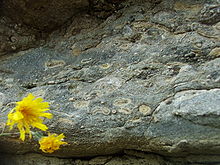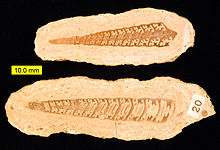Oncolite


Oncolites are sedimentary rocks that contain oncoids or are even predominantly built up by them. The term goes back to the geologist Albert Heim , who coined it in 1916.
Structure and creation
The oncoids are products of biogenic precipitation , e.g. B. by algae , and are irregularly rounded, often circular or elliptical in shape. In them, a layered, concentrically structured shell, usually made of calcium carbonate , surrounds a center that sometimes consists of sedimentary particles such as mussel shells . The shell structure can be irregular in larger oncoids and is interrupted on the side resting on the sediment. In contrast to the similarly structured ooids , usually a few millimeters in size , oncolites with a diameter of several centimeters are often much larger. Like ooids, they arise in marine and sea areas with moving water, but with lower sediment input.
The matrix of the oncolites in which the onkoids occur is also widespread, also carbonate, and contains other biological residues such as shells and crinoid residues . Some oncolites smell bituminous after being broken .
Oncoids are already known from the Proterozoic, but they also occur in younger rocks. Examples of today's oncoids are the Schnegglisteins of Lake Constance .
Recent or sub-recent freshwater oncoids in the Alz (Chiemgau, Upper Bavaria)

The Alz , the outflow of the Chiemsee , is a warm summer and winter cold as well as lime-rich flowing water, in the upper reaches of which (Obere Alz) between Seebruck and Altenmarkt an der Alz freshwater oncoids and oncolith formation (limestone surfaces or limestone cliffs) occur in some favorable places. The Chiemsee serves the river as an upstream buffer in terms of water flow (quantity) and sediment flow. The seasonal floods with strong turbidity or bed load management of the Tiroler Ache , on the one hand when the snow melts in spring, on the other hand during long periods of rain in summer, reach the Alz significantly attenuated.
Without this buffering, the growth of the oncoids would not be possible, because suitable formation conditions are only given with a suitable flow rate, sufficient light (low turbidity) and sufficient heat. Especially in the uppermost section to Truchtlaching (low gradient / low flow velocity), extensive areas with oncoids and oncolites are documented.
The limestone layer that grows on the cores (nucleus) from fluvio-glacial pebbles is formed by calcifying cyanobacteria . Layer thicknesses of several centimeters are not uncommon. By laying out marked nuclei (growth experiment) and observing them over several years, the in situ growth of the Alz onkoids could be demonstrated.
Recent or sub-recent freshwater oncoids in Moosach near Freising (Upper Bavaria)
The Moosach is a left tributary of the Isar; its source was originally in the area of the Moosach district in Munich . In the Freising area , the river runs in the Isar floodplains parallel to the Isar , into which it flows. Shortly before the confluence at Oberhummel, between the villages of Hangenham and Asenkofen, the occurrence of recent oncoids (tufa onciods) is described in the booklet to the international Kalkowsky Symposium "Geobiology of Stromatolites", 2008. The size of the recent oncoids is given as 2–15 cm. Express reference is made to the comparability of the conditions in other pre-Alpine rivers z. B. Alz are observed and documented.
Web links
Individual evidence
- ↑ Hans Murawski: Geological Dictionary . 8th edition. Enke, Stuttgart 1983, ISBN 3-432-84108-6 , pp. 155 .
- ↑ a b Hans Füchtbauer: Sediments and sedimentary rocks . 4th edition. Schweizerbart'sche Verlagsbuchhandlung, Stuttgart 1988, ISBN 3-510-65138-3 , pp. 300 f., 757 f .
- ↑ Mineral Atlas: Onkoid
- ↑ Corsetti, FA, Awramik, SM; Pierce, D .: A complex microbiota from snowball Earth times: Microfossils from the Neoproterozoic Kingston Peak Formation, Death Valley, USA . In: Proceedings of the National Academy of Sciences . 100, No. 8, April 15, 2003, pp. 4399-4404. doi : 10.1073 / pnas.0730560100 . Retrieved June 28, 2007.
- ↑ a b c D. Hägele: Morphogenesis, growth and ecology of the modern freshwater oncoids of the Alz . Dissertation at the Faculty of Geosciences, Ludwig Maximilians University Munich, 2006 ( online version; PDF file; 8.6 MB ).
- ↑ a b E. Rott: The algae growth in the Upper Alz (Upper Bavaria) . In: Reports of the scientific-medical association in Innsbruck . tape 81 . Innsbruck 1994, p. 229–253 ( online version; PDF file; 7.6 MB ).
- ↑ NN: Stop 7: Tufa oncoids of the river Moosach, Molasse Basin . In: Geobiology of Stromatholites - International Kalkowsky Symposium . Göttingen 2008, p. 193–197 ( online version; PDF file; 8.4 MB ).
